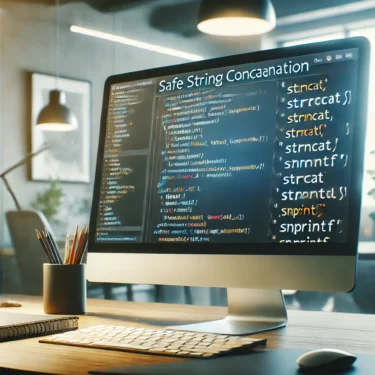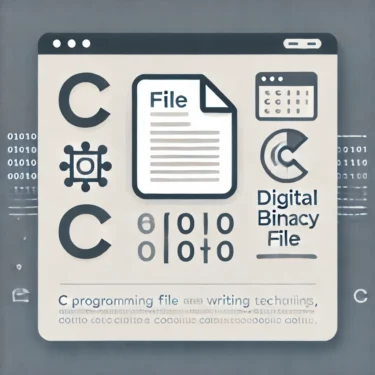1. Introduction
In programming, string manipulation is a fundamental and frequently used skill. In particular, C requires you to handle strings efficiently and safely, but this can be more challenging compared to other high-level languages. The main reason is that C does not have a dedicated string type; instead, strings are generally handled as arrays.
This article provides a detailed explanation of “string concatenation” in C. String concatenation is the process of combining multiple strings into one, which is useful in various scenarios such as data merging and generating display content. However, due to safety and performance concerns in C, there are several important considerations that must be understood.
By reading this article, you will gain a clear understanding of the following points:
- The basics of strings in C and methods for concatenation
- Best practices for safe concatenation
- Practical code examples
By mastering string concatenation techniques, you can make your C programming more powerful and flexible. In the following sections, we will explain specific concatenation methods and tips for using them safely.
2. String Basics in C
To understand string manipulation in C, you must first grasp how strings are handled in the language. Unlike other high-level languages, C does not have a built-in string type. Instead, strings are handled as arrays. This section explains how to define strings in C and covers basic operations.
Defining and Handling Strings
In C, strings are declared as arrays of the char type. A string is a sequence of characters that must end with a '\0' (null character). This terminating character tells the computer, “This is where the string ends.”
Declaring a String
The basic way to declare a string is as follows:
char str[20] = "Hello, World!";In the example above, a char array named str of length 20 stores the string “Hello, World!”. The null terminator '\0' is automatically added at the end, so the array length consists of 19 characters plus the null terminator.
Importance of the Null Terminator
In C, the end of a string is determined by '\0'. Without this terminator, functions that handle strings will read beyond the intended memory area, which may cause unexpected errors or crashes. Always ensure that strings are null-terminated.
Example: Problems Without a Null Terminator
char str[5] = {'H', 'e', 'l', 'l', 'o'};In this example, there is no '\0', so the data is not recognized as a proper string. Using printf may display unintended data from memory or cause the program to crash.
String Manipulation in C
C provides a set of convenient standard library functions for string manipulation via the <string.h> header. These include functions like strcat, strlen, and strcmp, which allow you to check string lengths, concatenate strings, and compare them.
By learning these basic functions, you can handle strings in C safely and efficiently.
3. Methods of String Concatenation
There are several ways to concatenate strings in C. Common methods include strcat and strncat, but you can also use sprintf or perform manual concatenation depending on your needs. This section explains each method with examples and important considerations.
Using strcat
What is strcat?
The strcat function appends one string to the end of another. It is available by including the <string.h> header.
Basic Example
#include <stdio.h>
#include <string.h>
int main() {
char str1[20] = "Hello, ";
char str2[] = "World!";
strcat(str1, str2);
printf("%s\n", str1); // Output: Hello, World!
return 0;
}Caution: Buffer Overflow Risk
If the destination array is too small, strcat may cause a buffer overflow, writing beyond allocated memory. Always ensure the buffer has enough space before concatenating.
Using strncat
What is strncat?
The strncat function works like strcat but allows you to specify the maximum number of characters to append. This helps prevent buffer overflows and improves safety.
Basic Example
#include <stdio.h>
#include <string.h>
int main() {
char str1[20] = "Hello, ";
char str2[] = "World!";
strncat(str1, str2, 5); // Append only 5 characters
printf("%s\n", str1); // Output: Hello, Worl
return 0;
}In this example, only the first five characters of str2 are appended to str1. This limits the risk of adding overly long strings that could exceed the buffer size.
Using sprintf
What is sprintf?
The sprintf function formats data into a string and writes it to a buffer. It is useful when you need to combine strings with numbers or other variables into a single formatted string.
Basic Example
#include <stdio.h>
int main() {
char str[50];
int num = 123;
sprintf(str, "The number is %d", num);
printf("%s\n", str); // Output: The number is 123
return 0;
}This method lets you embed numbers and variable values into strings, enabling flexible concatenation.
Manual Concatenation
Advantages and Method
Manual concatenation using loops allows for fine-grained control over how strings are joined, which can be useful in certain cases.
Basic Example
#include <stdio.h>
int main() {
char str1[20] = "Hello, ";
char str2[] = "World!";
int i, j;
// Find the end of str1
for (i = 0; str1[i] != '\0'; i++);
// Copy str2 into str1
for (j = 0; str2[j] != '\0'; j++) {
str1[i + j] = str2[j];
}
// Add null terminator
str1[i + j] = '\0';
printf("%s\n", str1); // Output: Hello, World!
return 0;
}Here, the program finds the end of str1, copies the contents of str2 character by character, and then adds a null terminator.
4. Best Practices for Safe String Concatenation
If not done properly, string concatenation in C can lead to buffer overflows and unpredictable behavior. Such issues can overwrite unrelated memory, cause instability, or even create security vulnerabilities. The following best practices help ensure safe concatenation.
Proper Buffer Size Management
Avoid Exceeding Buffer Size
Always verify that the concatenated result will fit in the buffer. For example, concatenating "Hello, " and "World!" into a 20-character buffer is fine, but adding more would require a size check.
Example: Checking Buffer Size
#include <stdio.h>
#include <string.h>
int main() {
char str1[20] = "Hello, ";
char str2[] = "World!";
if (strlen(str1) + strlen(str2) < sizeof(str1)) {
strcat(str1, str2);
} else {
printf("Buffer is too small\n");
}
printf("%s\n", str1); // Output: Hello, World!
return 0;
}This checks whether str1 can hold the result before concatenating, reducing overflow risk.
Using snprintf
The snprintf function writes formatted data into a buffer while limiting the number of characters written, reducing the risk of overflow. It is included in <stdio.h>.
Example: Using snprintf
#include <stdio.h>
int main() {
char buffer[20];
snprintf(buffer, sizeof(buffer), "%s %s", "Hello,", "World!");
printf("%s\n", buffer); // Output: Hello, World!
return 0;
}This ensures the final string fits in the buffer without exceeding its capacity.
Using Dynamic Memory Allocation
When concatenated string sizes vary or are unknown in advance, you can use malloc and realloc to dynamically allocate memory, allowing for flexible handling of larger strings.
Example: Dynamic Allocation
#include <stdio.h>
#include <stdlib.h>
#include <string.h>
int main() {
char *str1 = malloc(20);
strcpy(str1, "Hello, ");
char *str2 = "World!";
// Reallocate memory for concatenation
str1 = realloc(str1, strlen(str1) + strlen(str2) + 1);
strcat(str1, str2);
printf("%s\n", str1); // Output: Hello, World!
free(str1); // Free memory
return 0;
}Here, memory is resized as needed. Always remember to free dynamically allocated memory after use.
Summary of Safe Concatenation Tips
- Check buffer size before concatenation to avoid overflow.
- Use safer functions like
strncatorsnprintf. - Consider dynamic memory allocation when string sizes are variable or unknown.
5. Practical Code Examples
Here are example implementations of different string concatenation methods in C. Use them as a reference for choosing the right approach for your situation.
1. Basic strcat
#include <stdio.h>
#include <string.h>
int main() {
char greeting[30] = "Hello, ";
char name[] = "Alice";
strcat(greeting, name);
printf("%s\n", greeting); // Output: Hello, Alice
return 0;
}2. Safe strncat
#include <stdio.h>
#include <string.h>
int main() {
char buffer[15] = "Hello, ";
char additionalText[] = "Wonderland!";
strncat(buffer, additionalText, 7);
printf("%s\n", buffer); // Output: Hello, Wonder
return 0;
}3. sprintf for Formatted Concatenation
#include <stdio.h>
int main() {
char message[50];
int age = 25;
char name[] = "Alice";
sprintf(message, "Name: %s, Age: %d", name, age);
printf("%s\n", message); // Output: Name: Alice, Age: 25
return 0;
}4. Manual Concatenation
#include <stdio.h>
int main() {
char str1[20] = "Hello, ";
char str2[] = "C Programming";
int i, j;
for (i = 0; str1[i] != '\0'; i++);
for (j = 0; str2[j] != '\0'; j++) {
str1[i + j] = str2[j];
}
str1[i + j] = '\0';
printf("%s\n", str1); // Output: Hello, C Programming
return 0;
}5. snprintf with Dynamic Memory
#include <stdio.h>
#include <stdlib.h>
#include <string.h>
int main() {
char *dynamicStr = malloc(20);
if (!dynamicStr) {
printf("Memory allocation failed\n");
return 1;
}
strcpy(dynamicStr, "Hello, ");
char *additionalStr = "Dynamic World!";
dynamicStr = realloc(dynamicStr, strlen(dynamicStr) + strlen(additionalStr) + 1);
if (!dynamicStr) {
printf("Memory reallocation failed\n");
return 1;
}
strcat(dynamicStr, additionalStr);
printf("%s\n", dynamicStr); // Output: Hello, Dynamic World!
free(dynamicStr);
return 0;
}6. Conclusion
This article has provided an in-depth explanation of string concatenation in C. Unlike many high-level languages, C string handling can be complex, and attention to safety is essential.
Key Points
- String Basics: Strings in C are arrays of
charand must be null-terminated ('\0'). - Concatenation Methods: Use
strcat,strncat,sprintf, manual concatenation, or dynamic memory allocation as appropriate. - Safety Practices: Always check buffer size, use safe functions, and free dynamically allocated memory.
By understanding and applying these techniques, you can perform safe, efficient, and flexible string concatenation in C, enhancing the reliability and maintainability of your programs.




